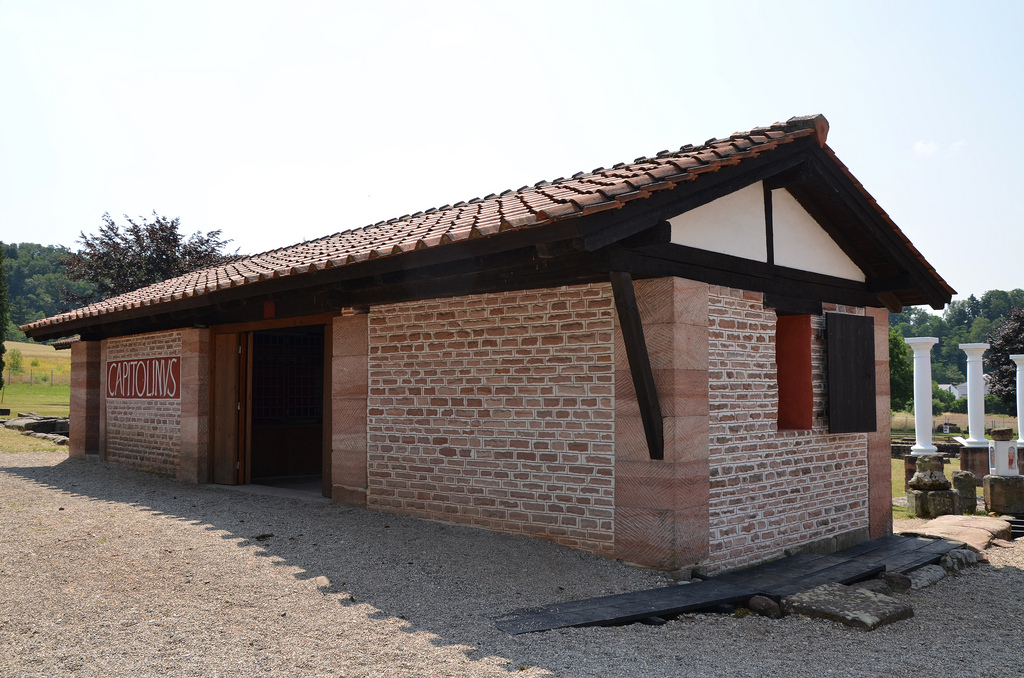The Schwarzenacker Roman Museum (German: Römermuseum Schwarzenacker) is an open-air archaeological museum in Schwarzenacker in Saarland (Germany) with several partly-reconstructed structures. The museum was built by archaeologist Alfonso Kolling who also led the archaeological excavations at the site. The site shows the remains of a Gallo-Roman settlement (its ancient name is lost) that existed from the beginning of the 1st century AD until its destruction by the Alemanni in AD 275.
Coordinates: 49° 16′ 58″ N, 7° 19′ 0″ E
Around 2,000 people inhabited the settlement which covered an area of approximately 25-30 hectares. The inhabitants benefited from the nearby Roman military and trade routes leading from Augusta Treverorum (Trier) to Argentoratum (Strasbourg) and from Divodurum (Metz) to Augusta Vangionum (Worms). This favourable location gave rise to a highly prestigious residential, commercial and administrative centre.
The urban planning of the settlement showed a clear Roman influence with streets intersecting at right angles. The main streets were flanked by large drainage channels while covered walkways led to the shop counters and workshops. Freshwater, pumped from deep wells, was supplied by pipelines of clay and wood. A stone relief with Venus, Cupid, and the Three Graces was found in one of the wells. The half-timbered houses of varying sizes were sometimes decorated with high-quality frescoes and ceiling paintings. One house differed from the standard types; it had a hall with a large cellar with a row of five columns running along the centre to support the wooden ceiling of the cellar (two of them were table columns with round stone slabs). Life-size figures were represented on one of the walls of the house. Six bronze statuettes were also found in the cellar: a Genius populi Romani; a seated Mercury with wild boar, a rooster; a standing Mercury; an Apollo, a seated Neptune; and a Victory. The house was probably the seat of a cult.
In the adjoining 18th century Baroque villa, important finds from everyday Roman life are exhibited (although the most important ones are in the Museum of Pre- and Early History in Saarbrücken). In front of the Baroque Edelhaus stand life-size replicas of two unfinished Roman equestrian sculptures which were discovered in 1887 in a Roman quarry at Breitfurt. They weight about 5000 kg each and are considered to be the largest Roman statues found north of the Alps.
PORTFOLIO
























The site is open daily from 9am to 5pm from April to October (Saturday and Sunday: Closed from 12:30pm to 1pm) and from 10am to 4pm from November to March (Saturday and Sunday: Closed from 12:30pm to 1pm). It is closed in December and January.
Website: www.roemermuseum-schwarzenacker.de
 The Saarland and Mosel Valley’s ancient Roman heritage has a lot to offer to tourists and scholars alike. More than 120 antique sights along the Moselle and the Saar rivers, the Saarland and Luxembourg are a testament to the Gallo-Roman era north of the Alps (further information here).
The Saarland and Mosel Valley’s ancient Roman heritage has a lot to offer to tourists and scholars alike. More than 120 antique sights along the Moselle and the Saar rivers, the Saarland and Luxembourg are a testament to the Gallo-Roman era north of the Alps (further information here).

Such a beautiful place Carole. And isn’t it nice to see the reconstruction.
LikeLike
Hi Carole I see you are coming to Crete in October. Would you have time to visit us. Agios Nikolaos Not far from Heraklion. We have room for you to stay.
LikeLiked by 1 person
Hi Rita, thank you so much for your offer. I have been working on my itinerary and I don’t think I will have time to visit the eastern part of the island. I already visited this part of the island in 2004 and the priority this time is to visit Phaistos and Gortyn and to go to Chania Museum to photograph the head of Hadrian. If anything changes and I can make it to Agios Nikolaos I will of course let you know.
LikeLike
Hi Carole, You will love Phaistos and Gortyn. What a shame I missed you in 2004 . Enjoy your visit and I will look forward to your post with your usual high standard photo’s.
LikeLike